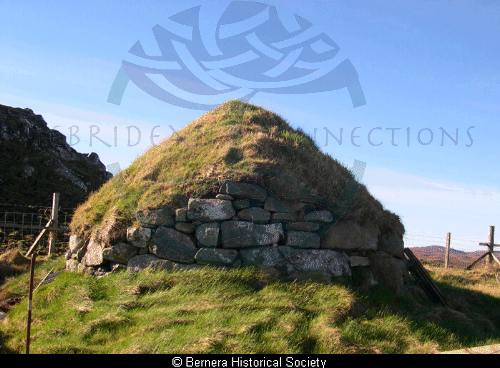46015: Both Cnoc Dubh II
A report written by James Crawford, Garynahine who restored the ‘both’ at Ceann Thulabhig in the first few years of 2000:
The Hebridean Both or Beehive (a descriptive term given in 1857 by Captain Thomas in his paper ‘A Notice of Beehive Houses in Lewis and Harris’) are to be found throughout Lewis and Harris, mainly on isolated sites and offshore islands. The Both belongs to that European tradition of corbelled structures that can be traced down the Atlantic seaboard to the Mediterranean basin.
In their Scottish context the remaining entire structures are to be found on the Hebridean islands of Lewis and Harris and their offshore islands of Sula Sgeir, North Rona, Eilean Fir Chroir, the Flannan Isles and St Kilda. In the southern Hebridean islands of the Uists, any remaining examples are now sadly gone. In mainland Scotland they occur although in a ruinous state on the Garvellachs although these are offshore islands. One did exist in the Campsie Woods until the twentieth century.
The structures use a corbelling technique called the Cyclopean arch or false arch of overlapping stones until they converge at the apex of the structure. Although this method relies to a great degree on the builders’ skill of utilising the balance of the stone, there exists a parallel development which the ecclesiastical structures used in particular but was also used in the traditional Both, that of using cantilevered ballast material. A good example of this method is the Taigh a’Bheannaich or Blessing House on Sula Sgeir – this structure collapsed after what was possibly twelve hundred years of exposure to what must be the most extreme weather in Europe. Gradually stones had fallen and some were taken for a variety of reasons until an imbalance was reached and the roof collapsed.
All throughout Lewis and Harris, peat turf had been utilised as the main cover of the Bothan. We have in Sula Sgeir Hebridean structures that very closely resemble their Irish and European counterparts in their building styles. The method of balancing stones and then applying the peat turfs to the stone carapace forms probably the method used in the majority of the Bothan in the Hebrides and shows the ingenuity of the builders at their best, relying completely on the balance and the friction of the stones to keep them in place. Some of the Bothan where this method has been applied and where the elements have stripped this away after the habitations were no longer used, show the skill of the builders by remaining intact some hundred and ten years after being photographed — an endearing monument to their skills.
We are then faced with trying to place these structures in the archaeological landscape. Who first built them? Why? When? Recorded Hebridean history has them firmly in the transhumance mainly and ecclesiastical as a minor player but perhaps it was from the ecclesiastical disuse of these structures that they were adopted for secular use? Certainly in the European dimension, there are people still using the structures for the yearly cycle of taking animals to the summer pastures. Or are they an even earlier type of habitation structure that has gradually evolved into transhumance and ecclesiastical use? We are certainly faced with accepting that there is a strong case to be made in recorded church history for this view.
previous excerpt ~ next excerpt
Details
- Record Type:
- Story, Report or Tradition
- Type Of Story Report Tradition:
- Report
- Record Maintained by:
- CEBL
